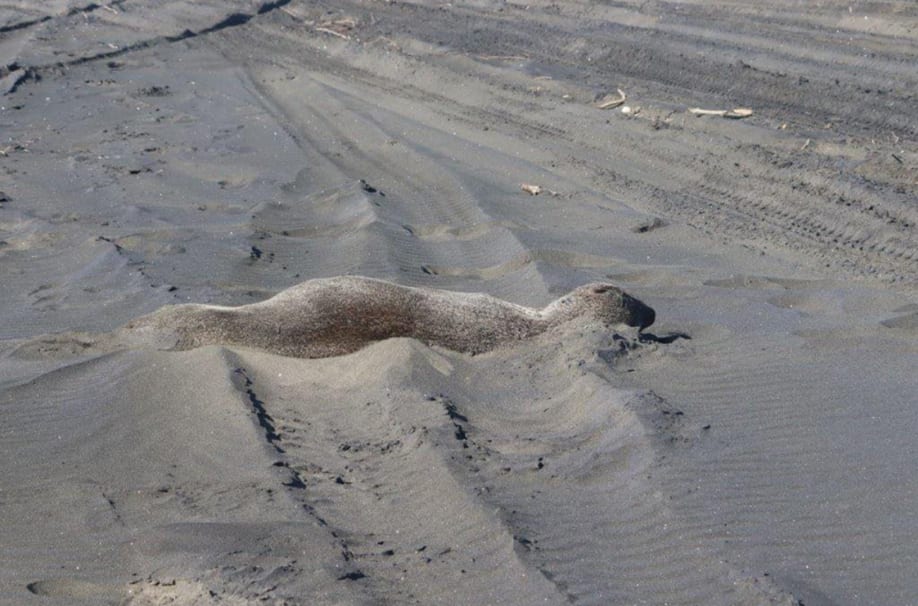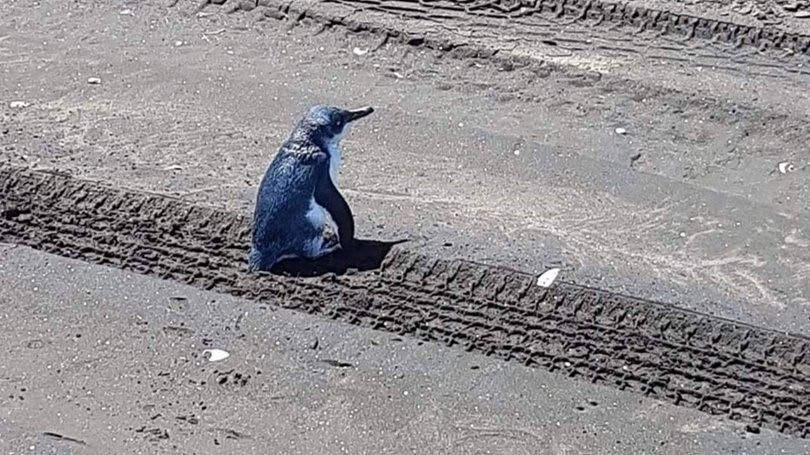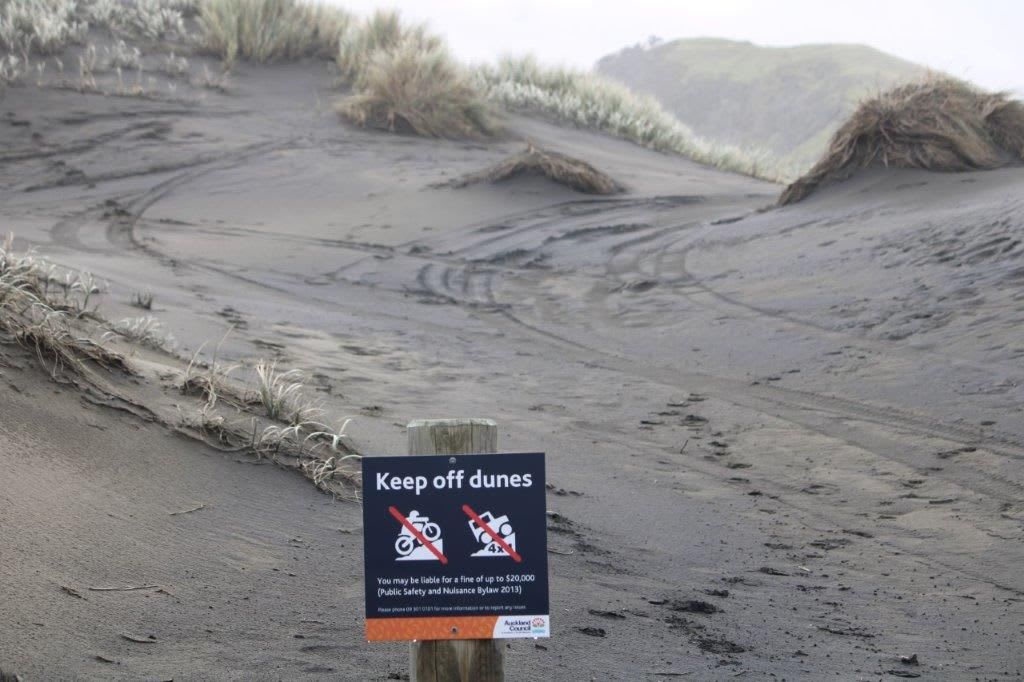
After a brief car ban for the peak of the summer holiday period, vehicles are back on Muriwai Beach. But what does this mean for the area’s fragile ecosystem?
A well-used and popular highway - and home to some of the country’s most vulnerable and at-risk species.
That’s the double life of a famous stretch of beach over in the northwestern corner of Auckland City.
Come summer, Muriwai is flooded with tourists seeking refuge on its vast expanses of black sand, less than an hour from the city.
But while it’s a well-trodden playground for summering urbanites, it’s also a vital refuge for a line-up of birds and sea creatures sometimes put at risk by the frolicking of humans.
Kororā (little blue penguin), toheroa (beach clams) and the seldom-seen Muriwai gecko are all put in danger by ongoing use of vehicles down the beach, argues Carl Morgan, Auckland’s regional conservation manager for Forest & Bird.
Then there’s the nesting sites for shorebirds like taranui (Caspian terns), tara (white-fronted terns) and tōrea (variable oyster catchers).
Forest & Bird is calling for tighter restrictions on vehicle access to beaches across the country, but the huge numbers of tyre tracks on Muriwai Beach have brought the west coast locale right into the spotlight.
Across 2021, around 64,500 vehicles accessed the beach, while data up to November shows 54,000 vehicles used the black sand highway through 2022.
Busy days can see over 1400 vehicles on the beach over the course of 24 hours.
That’s similar to the average weekly amount seen on suburban streets in places like Greenlane, Takanini or Te Atatu - the difference being that Matai Rd in Greenlane doesn’t have large communities of birdlife going through crucial parts of their life cycle in the roadway.
Morgan said even if cars don’t collide with the birds, traffic can drive them away from important nesting sites.
“The obvious risks are death or collision with wildlife but a single tyre track can actually destroy a nest,” he said.
Stuff recently reported on quad bikers in Golden Bay forcing threatened oystercatchers to leave their nests.
But according to Morgan, the list of potential negative impacts vehicle use can have goes on.
Off-road vehicles can rip up plants along shorelines and estuaries which provide habitat for protected species, while the noise and vibration of cars, trucks and bikes can send the birdlife packing.
Sometimes it’s more violent. Morgan shared pictures taken on Muriwai that show a single tyre track running over the corpse of a seal, half interred in the piling sand.
“I don’t know if it was already dead or not,” he said.

His message to would-be beach motorists is to take the chance to connect with nature without a windshield in the way.
“Listen to the waves, breathe in some fresh air and just enjoy it, while knowing you won't be harming any of our indigenous species,” he said. “We are currently in a biodiversity crisis and can't afford to be losing any more of these creatures. I don’t want anyone to be talking about a little blue penguin, fur seal or dotterel as something of the past.”
Vehicle access to Muriwai is allowed so long as the driver has a permit, although this week marks the end of a brief ban over the busy summer holiday period.
Between December 30 and January 16, the beach was closed to cars, but as of this Monday they are back.
Morgan said considering how busy the height of summer can be for the unofficial Muriwai highway, that ban could have stopped 2000-3000 additional vehicles.
“Obviously that’s reducing the risks,” he said. “But ultimately it’s a total ban that would be most effective. They need to start taking account for biodiversity, because at the moment I don’t think they do.”
A gate- and fee-based permit system was voted on last September by Auckland Council’s Parks, Arts, Community and Events Committee, after the council engaged with both Muriwai locals and beach users about the pros and cons of the decision.
Stephen Bell, Auckland Council principal specialist of regional parks, said it was important to find the right balance of interests for all beach users to ensure everyone’s safety and enjoyment of the beach.
“However, we also must put measures in place to protect Muriwai’s unique environment and to reduce fire risks,” he said.
He said one of the challenges Council faces is the ongoing use of the beach by unregistered vehicles such as dirt bikes and dedicated off-road buggies, neither of which can lawfully use the beach.
“Getting those off the beach would be a good step to achieve.”

The Parks, Arts, Community and Events Committee also approved the vehicle ban.
Committee chair and Auckland Councillor Richard Hills last month put public safety and fire risks as top reasons for the ban, but also referred to the area’s ecosystem.
“Muriwai has important eco-systems that are fragile,” he said. “If we all follow the rules, then we can all enjoy Auckland’s amazing west coast and ensure our unique native species are able to thrive as well.”
However, Morgan questions whether even responsible and law-abiding use of the beach as a roadway leaves the birdlife protected.
He referred to a recent experience he had, making his way to a surf spot near Port Waikato. Walking down the beach, he almost tripped over an injured white-fronted tern on the beach.
“I almost tripped over the poor thing, so I really don’t like its chances if I were to be in a vehicle.” he said. “They’re so camouflaged.”
And from the insulated position behind a four-wheel drive’s steering wheel, he wonders whether drivers would even realise they’ve gone through a nest.
“A single tire over a nest of two or three eggs or a juvenile chick - that’s all it would take.”

Going for a beach drive seems to be a pastime growing in popularity, with vehicle use between October and December more than doubling in the period between 2016 and 2021, according to Auckland Council.
Alongside that, there’s been a 259 percent increase in vehicle movements onto and off the beach at Coast Road, the northern vehicle access point.
In past years, police have patrolled Muriwai during the warmer months as a part of Operation Black Sands, focusing on motorists misusing vehicles and dangerous driving.
For much of Muriwai Beach, motorists must keep to 60km an hour and keep out of the dunes.
However, Morgan has photos of the ‘Keep Off Dunes’ sign with a worming network of interwoven tyre tracks.
The rules and permits may be in place, but it might just not be making enough of a difference for the terns and the oystercatchers living a short drive from New Zealand’s biggest city.







